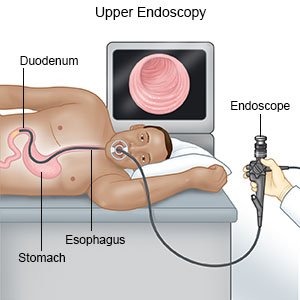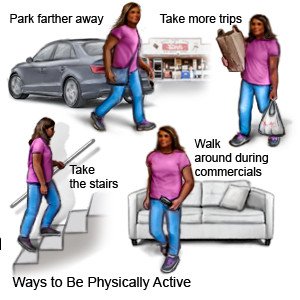Intragastric Balloon (Igb) Procedure for Weight Loss
Medically reviewed by Drugs.com. Last updated on Aug 4, 2025.
AMBULATORY CARE:
What you need to know about an IGB procedure:
- The IGB procedure uses a balloon that is placed down your throat into your stomach. Placement of the balloon may be through endoscopy, a tube with a light and camera at the end. You may instead swallow a capsule that contains the balloon. The balloon is filled with saline or a gas that causes you to feel full quicker and be less hungry. The balloon takes up space in your stomach and causes food to move through slower than normal.
- You may need more than 1 balloon depending on the type you receive. Some balloons are adjustable so more fluid can be added. The balloon is left in your stomach between 4 and 6 months. IGB is less invasive than other weight loss surgeries. After the procedure, you will follow a supervised 12-month diet and exercise plan and see your weight loss team monthly.
How to prepare for an IGB procedure:
First you must be able to lose some weight on your own with lifestyle changes. Changes include food choices and physical activity. You will need to be evaluated by a team including a bariatric doctor, dietician, and psychologist. You will have an endoscopy to check for any problems in your esophagus, stomach, and small intestines. Ulcers in your esophagus or stomach, or a large hiatal hernia can prevent you from having the procedure.
- Days before your procedure:
- Arrange to have someone drive you home and stay with you for 24 hours after your procedure.
- You will be given prescriptions for anti-nausea and acid reflux medicines. Make sure you have prescriptions filled before your procedure.
- The day before your procedure: You will be told not to eat 12 hours before your procedure. You may be told not to drink 6 hours before your procedure. Your surgeon will tell you which medicines are okay to take before your procedure.
What will happen during an IGB procedure:
There are 2 types of procedures for the 2 types of balloons.
- Endoscopic placement:

- You will be given a mild sedative. You will not feel pain, but you may feel pressure.
- The surgeon will place an endoscope in your mouth and down into your stomach. The endoscope has a light and camera on the end to help your surgeon see where the balloon will be placed.
- He or she will place the balloon through the endoscope. When the balloon is in your stomach, it is filled with saline.
- The endoscope is removed.
- Pill placement:
- Your surgeon will give you a capsule to swallow that contains the balloon.
- You will swallow the capsule and drink a cup of water.
- The surgeon will inflate the balloon with gas. A second balloon is added in 1 month. A third balloon will be added in 2 months.
What to expect after an IGB procedure:
You should be able to go home 1 to 2 hours after the procedure. You may have some cramping or pain, nausea, and vomiting after placement. These symptoms may last from a few days up to 2 weeks. This is normal. Your weight loss team will give you guidance on taking medicines for your symptoms and your eating plan. You will only be able to drink clear liquids slowly for about 3 to 7 days. You will need follow up with your weight loss team as directed for the next 12 months.
Risks of an IGB procedure:
Complications are very rare. Your intragastric balloon may deflate and move into your digestive system. Your balloon may be inflated too much. You may develop inflammation in your pancreas (pancreatitis). You may develop ulcers in your stomach wall. You will need surgery to remove the balloon and fix any of these problems.
Call your surgeon if:
- You have pain, nausea, or vomiting that continues even after you take medicine.
- The color of your urine changes to blue-green. This means your balloon has leaked.
- You are constipated or cannot pass gas.
- You have new pain that is different than pain after your procedure.
- You have sudden swelling in your abdomen.
- You no longer feel full.
- You have increased hunger.
- You have questions or concerns about your procedure or care.
What to eat after your procedure:
You may not feel like eating for the first week. This is normal. Your surgeon or dietician will go over your eating plan before your procedure. They may tell you the following:
- Stage 1 (for about 3 to 5 days after placement):
- Drink at least 8 cups (64 ounces) of only clear liquids. Examples include water, sugar-free sports drinks, tea, broth, popsicles, or gelatin, and apple, white grape, or cranberry juice. Fruit juices should have no added sugars. You should mix ½ water with fruit juices.
- Drink 1/3 of a cup at a time.
- Sit upright. Take small sips. Wait for 1 or 2 minutes between sips.
- Drink warm liquids.
- Avoid:
- Cold liquids
- Carbonated drinks
- Sugary drinks
- Citrus juices such as orange, pineapple, lemonade
- Tomato juice
- Alcohol
- Caffeinated drinks such as coffee and energy drinks
- Stage 2 (you may need a blender or food processor):
- Protein shakes
- Greek yogurt (plain), sugar-free pudding
- Vegetable juice
- Pureed fruits and vegetables
- Blended soups
- Avoid:
- Foods with large chunks
- Sugary foods such as desserts
- Carbonated drinks
- Stage 3 (foods that can be easily mashed with a fork):
- Cottage cheese, ricotta cheese, string cheese
- Scrambled eggs, beans, deli meat, tofu
- Avocado, well-cooked or mashed vegetables
- Soft fish, crab, canned chicken, tuna, or salmon
- Stage 4 (solid foods):
- Eat a variety of healthy foods. Focus on lean protein and non-starchy vegetables.

- Eat small meals.
- Drink at least 64 ounces of water every day.
- Keep a food journal.
- Limit the amount of alcohol you drink.
- Avoid:
- Sweets and processed foods
- Foods made from dough, such as bread (it may stick to your balloon)
- Eat a variety of healthy foods. Focus on lean protein and non-starchy vegetables.
Healthy tips to help with cramping and nausea:
- Sit tall when you eat or drink. Do not slouch.
- Eat slowly. Chew your food well before you swallow.
- Drink at least 64 ounces of water every day.
- Do not drink liquids for 30 minutes before you eat. Wait for 30 minutes after you eat to drink liquids.
- Stop eating if you feel full or have heartburn.
- Do not eat for 3 hours before bed.
- Use pillows to prop yourself up at night to sleep if you have heartburn.
Activity expected:
Your weight loss team will help you make a plan for physical activity that you will be able to do. You may not be able to start your activity until a week after your procedure. The activity will include something you can do 30 minutes a day, 5 days a week. It may start with walking and increase slowly. Continue the activity even after your balloon is removed. Exercise activity will help prevent weight gain.
 |
Follow up with your doctor or surgeon as directed:
Write down your questions so you remember to ask them during your visits.
© Copyright Merative 2025 Information is for End User's use only and may not be sold, redistributed or otherwise used for commercial purposes.
The above information is an educational aid only. It is not intended as medical advice for individual conditions or treatments. Talk to your doctor, nurse or pharmacist before following any medical regimen to see if it is safe and effective for you.
Further information
Always consult your healthcare provider to ensure the information displayed on this page applies to your personal circumstances.
